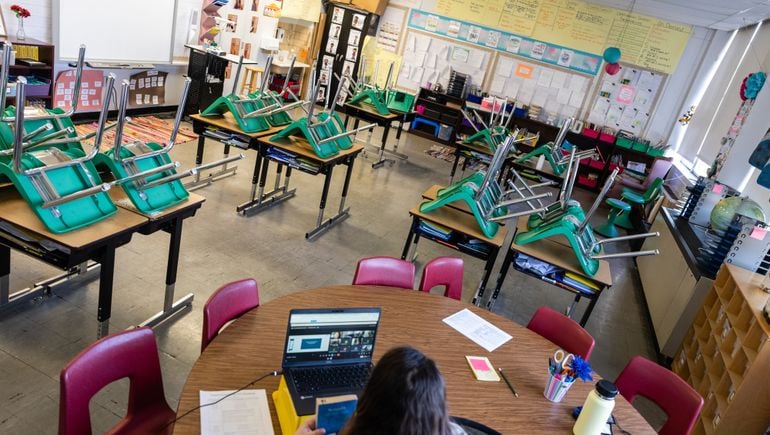Dive Brief:
- The number of students in public K-12 schools in fall 2021 fell 2% below projected levels, meaning about 833,000 fewer seats were filled and a higher education sector already bracing for an enrollment cliff now faces heightened risks.
- Reports of students struggling in class amid the COVID-19 pandemic could also foreshadow the number of high school graduates falling more sharply after 2025 than was previously expected, according to a new report from the Western Interstate Commission for Higher Education.
- Enrollment changes reflect some students shifting to homeschooling or private schools. But they also show particularly deep pandemic effects for several traditionally underserved racial and ethnic groups.
Dive Insight:
The K-12 pipeline’s health has been a top concern for colleges since the pandemic started disrupting education in 2020. Struggling students today can mean lower high school graduation rates in the future — and most colleges overwhelmingly depend on high school graduates to build each fall’s incoming class.
WICHE has become a go-to source of K-12 enrollment data and projections for college leaders who want to understand what future years are likely to bring. Its previous projections showed high school graduates peaking in 2025 and becoming much more diverse.
That prompted institutions to brace for what’s sometimes called the enrollment cliff or demographic cliff. Some admissions officers and equity advocates reject those terms, arguing colleges should be able to overcome topline declines in the number of high school graduates by reaching students they have not traditionally enrolled in large numbers, such as low-income and non-White students. Others point out that changes in the number of students will be different in individual states and regions compared to the national level, and that demand for college varies greatly by an institution’s market position.
Still, overall declines in K-12 students and high school graduates are generally regarded as downward pressure on the higher ed sector’s enrollment and financial prospects.
That backdrop adds even more import to the new WICHE report, which was released Tuesday. The conclusions that it draws are limited — it says currently available data doesn’t allow for the full effects of the pandemic to be known yet. But it nonetheless sketches a picture of where cracks have appeared in the K-12 pipeline.
The number of high school graduates for the classes of 2020 and 2021 were relatively stable, the report finds. That aligns with other research suggesting pandemic-era declines in college enrollment are driven by changing student behavior, not a drop in the number of high school graduates available to matriculate at colleges.
The WICHE report shows a bulge in 9th graders in fall 2021. Public schools’ 9th-grade enrollment grew by 4%, or 152,200 students, between fall 2020 and fall 2021. That’s about twice the rate of a year-over-year increase that had been expected for the cohort of students.
The change could reflect students reenrolling in public schools after homeschooling or turning to private schools in 2020. But WICHE also flagged evidence that more students repeated 9th grade after failing to move on to 10th grade.
“Concerningly, research indicates that students who get off the educational track in 9th grade are less likely to eventually graduate,” the report says.
Indicators from middle schools raise even more flags. Public schools’ enrollment of 6th, 7th and 8th graders fell by 2% in fall 2021, a sharper decline than an expected 1.4% decrease. Spring 2022 test scores show middle schoolers struggling more than younger students during the pandemic and failing to recover as quickly. Their math skills were hit particularly hard.
Enrollment in grades 1 to 5 recovered between fall 2020 and fall 2021 to resemble projected levels, WICHE found. But it again flagged declines in learning proficiency.
“If these factors were to remain unchanged, over time, this could compound future higher education enrollment challenges,” the report says.
Some public school enrollment declines might reflect increased private school or homeschool enrollment. That could be a boost to certain colleges that traditionally recruit heavily from private and homeschool populations. But the WICHE report cautions that it’s difficult to measure those students’ numbers and academic prowess, and that it’s not clear if pandemic-driven shifts will stick in the future.
WICHE also broke down enrollments by race and ethnicity. Available data suggested public school enrollment fell faster than expected for White non-Hispanic students, Black non-Hispanic students, Asian non-Hispanic students, and Native Hawai‘ian and other Pacific Islander non-Hispanic students.
“Pandemic impacts on historically underserved student populations could be a leading cause of potential disruption to the predicted number of U.S. high school graduates,” the report says.






Leave a Reply